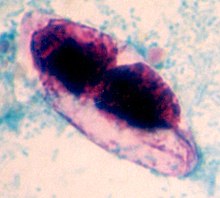| Cystoisospora | |
|---|---|

| |
| Strained oocyst of Cystoisospora belli | |
| Scientific classification | |
| Domain: | Eukaryota |
| Clade: | Diaphoretickes |
| Clade: | SAR |
| Clade: | Alveolata |
| Phylum: | Apicomplexa |
| Class: | Conoidasida |
| Order: | Eucoccidiorida |
| Family: | Sarcocystidae |
| Genus: | Cystoisospora Frenkel, 1977 |
| Species | |
| Synonyms | |
|
Levineia Dubey, 1977 | |
Cystoisospora is a genus of parasitic alveolates belonging to the phylum Apicomplexa.
Taxonomy
This genus was originally created by J. K. Frenkel in 1977. Its use was discontinued but was resurrected in 2005. This genus currently includes species that have oocysts containing two sporocysts with four sporozoites in each without Stieda bodies. These species infect the enterocytes of mammals and are transmitted by the orofaecal route.
DNA analysis has shown that this genus belongs to the family Sarcocystidae.
The type species of this genus is Cystoisospora felis.
Life cycle
This parasite has been isolated from dogs, cats and raccoons. C. belli has been isolated from immunosuppressed humans — particularly those with HIV infection.
These parasites normally infect the enterocytes of the small intestine and are spread by the orofaecal route. The definitive hosts are cats but other species including various species of rodents may be infected. No further development occurs in these paratenic hosts and the parasites remain dormant until ingested by a definitive host.
Epidemiology
This genus has been recorded worldwide. C. felis and C. rivolta occur in up to 40% of cats in some tropical countries.
Clinical
Clinical signs include watery diarrhea, vomiting, fever and weight loss. The diagnosis is made by microscopic examination of the stool. Distinguishing between the species of Cystoisospora is most easily done with PCR. This method can also be used to make the diagnosis.
Treatment is based on trimethoprim-sulfonamides with clindamycin or toltrazuril for resistant strains.
Prevention
Hygiene on the premises is important in prevention. Good litter tray hygiene is also critical in multi-cat households. Utensils, runs, cages and other implements should be steam-cleaned or washed in boiling water. Because of the importance of paratenic hosts such as cockroaches, insect control is critical.
References
- "Cystoisospora". NCBI taxonomy. Bethesda, MD: National Center for Biotechnology Information. Retrieved 16 January 2019.
- ^ Barta, JR; Schrenzel, MD; Carreno, R; Rideout, BA (June 2005). "The genus Atoxoplasma (Garnham 1950) as a junior objective synonym of the genus Isospora (Schneider 1881) species infecting birds and resurrection of Cystoisospora (Frenkel 1977) as the correct genus for Isospora species infecting mammals". The Journal of Parasitology. 91 (3): 726–7. doi:10.1645/GE-3341.1. PMID 16108579.
- Samarasinghe, B; Johnson, J; Ryan, U (April 2008). "Phylogenetic analysis of Cystoisospora species at the rRNA ITS1 locus and development of a PCR-RFLP assay". Experimental Parasitology. 118 (4): 592–5. doi:10.1016/j.exppara.2007.10.015. PMID 18067892.
- Schuster, RK; Thomas, K; Sivakumar, S; O'Donovan, D (July 2009). "The parasite fauna of stray domestic cats (Felis catus) in Dubai, United Arab Emirates". Parasitology Research. 105 (1): 125–34. doi:10.1007/s00436-009-1372-6. PMID 19238440.
- Coelho, WM; do Amarante, AF; de Soutello, RV; Meireles, MV; Bresciani, KD (2009). "Occurrence of gastrointestinal parasites in fecal samples of cats in Andradina City, São Paulo". Revista Brasileira de Parasitologia Veterinaria (in Portuguese). 18 (2): 46–9. doi:10.4322/rbpv.01802010. hdl:11449/14788. PMID 19602317.[REDACTED]
- Lloyd, S; Smith, J (21 April 2001). "Activity of toltrazuril and diclazuril against Isospora species in kittens and puppies". The Veterinary Record. 148 (16): 509–11. doi:10.1136/vr.148.16.509. PMID 11345994.
| Taxon identifiers | |
|---|---|
| Cystoisospora | |